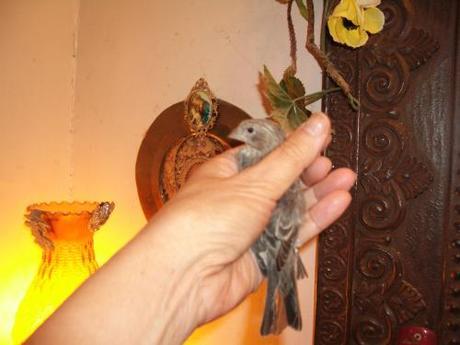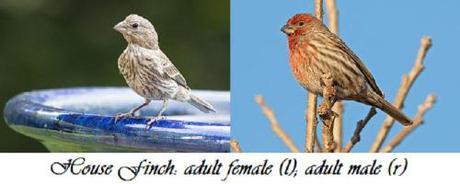
Meet Janie, the little house finch whom I’d rescued as a fledgling ten years ago.
Her parents had built a little nest in a planter on the outside wall next to the front door of my townhouse. Mommy laid three eggs, all of which hatched. But after the first two fledglings flew from the nest, little Janie remained, too immature to fly.
I kept a watch on her, peering into the nest every day.
One afternoon, I heard the distressed chatter of birds outside. I dashed out and saw little Janie on the ground, her parents by her side, clearly distressed. Unable to fly, Janie would not last long and would soon be captured by a cat or dog.
So I took her in.
I hand fed Janie a gruel of Kaytee powder formula for baby birds mixed with mango sherbet.
Fledglings I’d rescued in the past would subsist on the gruel for a week, then they naturally graduated to eating seed by themselves. But not Janie. I hand fed her for an entire month!
She is now 10 years 3 months old. In her old age, Janie can no longer fly and regularly flops to the bottom of her “townhouse.” So I placed twigs and tree branches in a zig-zag pattern, from the bottom of the large cage to the top, so she can hop from one to another and so make her way back to the top perch.
When I take her out in my cupped hand, she would give me little love nips with her beak.
~Eowyn

Haemorhous mexicanus
The house finch (Haemorhous mexicanus) is a bird in the finch family Fringillidae, which is found in North America. This is a moderately-sized finch. Adult birds are 4.9 to 5.9 in, with an average weight 0.74 oz.
In most cases, adult males’ heads, necks and shoulders are reddish. Male coloration varies in intensity with the seasons and is derived from the berries and fruits in its diet. Adult females have brown upperparts and streaked underparts. Their song is a rapid, cheery warble or a variety of chirps.
Originally only a resident of Mexico and the southwestern United States, they were introduced to eastern North America in the 1940s, then spread across the continent. Today, there are estimated to be anywhere from 267 million to 1.7 billion house finches across North America.
House finches forage on the ground or in vegetation normally. They primarily eat grains, seeds and berries, being voracious consumers of weed seeds such as nettle and dandelion; included are incidental small insects such as aphids.
Nests are made in cavities, including openings in buildings, hanging plants, and other cup-shaped outdoor decorations. Sometimes nests abandoned by other birds are used. Nests may be re-used for subsequent broods or in following years. The nest is built by the female, sometimes in as little as two days. It is well made of twigs and debris, forming a cup shape.
During courtship, the male will touch bills with the female. He may then present the female with choice bits of food, and if she mimics the behavior of a hungry chick, he may actually feed her. The male also feeds the female during the breeding and incubation of both eggs and young, and the male is the primary feeder of the fledglings. Females are typically attracted to the males with the deepest pigment of red to their head.
The female lays clutches of eggs from February through August, two or more broods per year with 2 to 6 eggs per brood, most commonly 4 or 5. The female always feeds the young, and the male usually joins in. Before flying, the young often climb into adjacent plants, and usually fledge at about 11 to 19 days after hatching.

